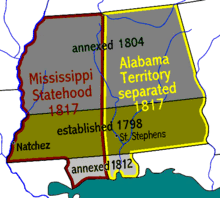History of Alabama
The history of Alabama began with the arrival of the first Indians in front of about 9000 years. The colonization of America by the Europeans began in the 16th century. In 1820 Alabama became a state in the United States .
Surname
The name goes back to an Indian tribe known as Alabama from the Muskogee language family , which was first mentioned in 1540 by participants in the Hernando de Sotos expedition . Garcilasso de la Vega called it the Alibamo , others called it Alibamu or Limamu . The French called them Alibamons in 1702 , accordingly the river was called Rivière des Alibamons on French maps .
history
Emergence of the state
Before European colonization , the area to the left of the Alabama River was inhabited by the Alabama people , an Indian tribe. The Coushatta settled to the right of the river . The Alabama area initially formed part of Florida, Spain . In 1698 the Frenchman Pierre Le Moyne d'Iberville landed not far from where Mobile is now . His intention was to establish a closer connection to the Mississippi for France, which in 1702 resulted in the construction of a fort in Mobile. However, little was done to colonize the country until around 1800. After the Revolutionary War , most of Alabama was part of Georgia . This left but in 1802 all the land west of the Chattahoochee River of the Union from it and from between the Perdido and Mississippi River formed an area located part of West Florida, which was divided into two territories in 1817, of which the eastern after its main river Alabama territory called that was struck western to the state of Mississippi . In 1819 the territory adopted a constitution and entered the Union as a state in 1820.

Civil War
In 1861 Alabama broke away from the Union and joined the Confederate States of America , whose central authority initially resided in Montgomery, Alabama . In the American Civil War , Montgomery was conquered after the Battle of Selma on April 12, 1865 by Union troops led by Major General James H. Wilson . In 1868 Alabama was re-admitted to the Union as a full state.
Great Depression and Post-War Period
During the depression of the 1930s , Alabama was a stronghold of support for the policies of Democratic President Franklin D. Roosevelt . The state benefited greatly from public investments such as B. by the Tennessee Valley Authority , as both construction and operation of the dams on the Tennessee River in the north of the state created jobs. The Rural Electrification Act (REA) was particularly important for the rural state.
After the Second World War, a period of transformation in Alabama's politics and society began. The dispute over racial segregation was fought out with extreme severity in Alabama (see also the Montgomery bus boycott ). Martin Luther King and Rosa Parks , but also Governor George Wallace , known far beyond the borders of Alabama as an opponent of integration , had their residence in Montgomery. It was not until 1967 that Alabama was forced by the Supreme Court to become one of the last states in the United States to lift the ban on mixed marriages . See Loving v. Virginia , 388 US 1 (1967).
Economically, with the onset of modernization, an influx of people from the northern states began. Nevertheless, there is now a predominance of Republicans in Alabama. The Democrats only have a majority in counties that have a majority of black voters. Bob Riley was elected governor of Alabama in November 2002 and re-elected in 2006. As of January 17, 2011, Republican Robert J. Bentley has been governor of the state of Alabama.
Individual evidence
- ↑ The State's Name. ( Memento of the original from June 28, 2007 in the Internet Archive ) Info: The archive link was inserted automatically and has not yet been checked. Please check the original and archive link according to the instructions and then remove this notice. In: Alabama Department of Archives and History. (engl.)
- ^ William A. Read: Indian Place Names in Alabama , University of Alabama Press 1984. (Eng.)
- ↑ Thomas McAdory Owen, Marie Bankhead Owen: History of Alabama and Dictionary of Alabama Biography. Vol. 2. De Luxe Supplement Edition. SJ Clarke, Chicago 1921, p. 1037. (Eng.)
- ↑ a b Alabama , The Collaborative Encyclopedia, Volume 1. Leipzig 1905, pp 248-249. ( Online )
- ^ Ronald Edsforth: The New Deal: America's Response to the Great Depression (Problems in American History). Blackwell, Malden 2000, ISBN 1-57718-143-3 . (engl.)

